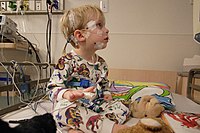
Photo from wikipedia
OBJECTIVE To explore impaired cognition characteristics and abnormal behavior in children with Sleep-Disordered Breathing (SDB) via Event-Related Potentials (ERPs), continuous performance testing (CPT), and the Child Behavior Checklist (CBCL). METHODS… Click to show full abstract
OBJECTIVE To explore impaired cognition characteristics and abnormal behavior in children with Sleep-Disordered Breathing (SDB) via Event-Related Potentials (ERPs), continuous performance testing (CPT), and the Child Behavior Checklist (CBCL). METHODS A total of 108 children aged 6-8 years old were recruited, including fifty-four children (28 boys) with SDB and fifty-four normal children (28 boys). CBCL and Chinese version of the OSA-18 questionnaire were administered. Nineteen children with SDB (OSA-18 questionnaire value >60) and Nineteen normal children completed a CPT task. ERP was extracted using the BESA software. RESULTS No significant differences in the correct number, reaction time, or the number of commission error were noted between the CPT of the two groups (P > 0.05). The ERP Go-P3 amplitudes at F3, Fz and F4 of the SDB group were significantly higher than those of the control group (P < 0.05). The NoGo-N2 amplitudes at F3 and Fz of the SDB group were significantly lower than those of the control group (P < 0.05). The Fz and F4 Go-P3 and FZ NoGo-P3 latency of the SDB group were significantly longer than those of the control group (P < 0.05). However, among boys, the CBCL scores of the SDB group including the subscores, schizo, somatic complaints, compulsion, aggression, and hyperactivity, as well as the total score, were significantly higher than the control group (all P < 0.05). CONCLUSION Children with SDB demonstrate significant functional deficits in regard to conflict monitoring, attention, and inhibition. The frontal region is the primary area of dysfunction, especially in the left brain region, and inhibition function dysfunction may be a common pathogenesis of SDB and ADHD. Moreover, boys with SDB may exhibit more behavior problems when compared to girls.
Journal Title: Brain and Development
Year Published: 2019
Link to full text (if available)
Share on Social Media: Sign Up to like & get
recommendations!